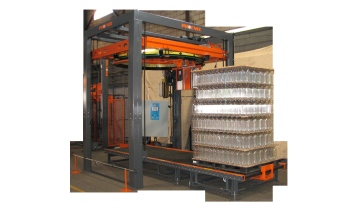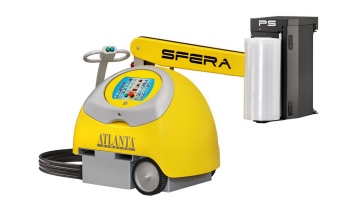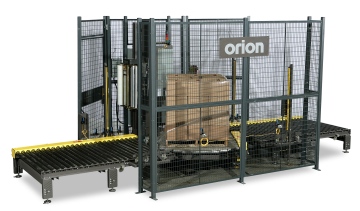
The Finishing Stretch
By Canadian Packaging Staff
General Orion Packaging Phoenix Innotech Premier Tech Systems Samuel Strapping Systems StretchwrappingStretchwrapping equipment design evolving with new end-use requirements.
Keeping a pallet loaded with packaged products safe and sound from shipment to customer delivery may not sound like one of the most glamorous packaging functions out there, but no self-respecting end-of-line packaging operation is really worthy of the name these days without at least one reliable, robust stretchwrapping machine in place to apply layers of stretchwrap film onto palletized loads to keep them stable and secure throughout their journey down the supply chain.
But while standard turntable and rotary-arm stretchwrapping technology has been largely bypassed by groundbreaking technological advances witnessed in some other packaging machinery segments, recent developments in the stretchwrapping systems and materials market suggest that this vitally important equipment category may be entering a far more exciting chapter in its evolution—driven by relentless technological innovation, ongoing costs-reduction efforts, and concerns about the environmental impact of tonnes of discarded stretchwrap film ending up at landfills around the globe.
Doing more with less appears to be the emerging new mantra for some of North America’s leading stretchwrapping equipment manufacturers and distributors, with technology-savvy companies like Phoenix Innotech Inc. of Laval, Que., setting the pace in new equipment design and performance capabilities.
“You cannot look at stretchwrap equipment improvements without addressing the improvements in stretch film,” says Phoenix Innotech general manager Graham Nicholson.
“With the vast improvements in stretch film technology, typical stretch film thicknesses have plummeted, and this ‘downgauge era’ has resulted in a real paradigm shift as to what is most required from stretchwrapping equipment today—as thin gauge films have eliminated the need for maximizing pre-stretch capabilities by up to 350 per cent.
“Now it is about providing a machine that can consistently run these light-gauge films and eliminating inherent deficiencies in the wrapping process,” says Nicholson, explaining that Phoenix has recently addressed the issue by upgrading its film carriage design to execute reliable wraps even with film defects like nicks, gel spots or holes without film breaks.
“There is one huge deficiency in the conventional wrapping process that is causing a strong wave of change,” says Nicholson, pointing out there’s been remarkably little real advancement in the mechanical design of most stretchwrapping systems in the 40 years since they were first commercialized.
“Turntable and rotary-arm technology has not really changed since the early 1970s,” relates Nicholson, deriding the “inherent deficiency” and “costly drawbacks” of having the clamp and the cutting system both located in a fixed location on the conveyor. This means that while the carriage moves to the top of the load to start a wrap cycle it must dispense wasted film as it moves to get there. These two or more extra revolutions only increase costs, waste and wrapping time, while bringing little additional, if any, load integrity to the load being wrapped.”
In fact, Nicholson contends, the costs of these extra film revolutions end up running into tens of thousands of dollars—money that could be easily recovered with his company’s rotary-ring machines whose clamp-and-cut mechanisms move within the carriage to eliminate the extra film revolutions and facilitate faster, more customized wrapping cycles. (Picture above on right)
“A recent customer who saved over $30,000 per year in stretch film costs likened it to using an old eight-pound satellite phone instead of a hands-free cellphone,” Nicholson recalls.
“Although patent issues prevented the widespread use of ring technology in North America to date, the overwhelming dominance of rotary-ring technology had already taken hold about 15 years ago in Europe, where today’s rotary-ring wrappers have effectively replaced the old conventional rotary-arm and turntable automatic machines,” Nicholson relates. “I don’t think it will be long before companies in North America begin switching en masse from the old turntables and rotary-arm machines to rotary ring equipment to take advantage of those cost benefits, and our company is actually leading the wave of this sweeping change by offering two models of rotary-ring systems to allow every level of end-user take advantage of this game-changing technology.”
Ryan Van Horne, marketing coordinator with the Mississauga, Ont.-based packaging equipment supplier Samuel Strapping Systems, agrees that Europeans have been far more adventurous than North Americans in pushing the envelope of stretchwrapping technologies by cleverly integrating robotics and machine vision into machine design to come up with mobile, subcompact, self-guiding stretchwrapping solutions such as the made-in-Italy Sfera robot wrappers (see picture below), which Samuel has recently brought into the Canadian market.
“While the technology is not new, the availability of these units to the Canadian market is,” says Van Horne, citing many self-evident operational flexibility advantages of battery-powered, self-propelled machines that can wrap up to 150 pallets per single charge.
“The Sfera machine allows companies to assemble their loads on the floor and bring the wrapper to the load, rather than the other way around,” Van Horne explains. “It also enables plants to wrap large loads considered too big for turntable or rotary-arm machines,” he elaborates, thanks to a unique design of a mechanism for raising and lowering the carriage to allow operation in low-headroom areas without the hassle of having to drop the traditional mast.
“The Sfera system’s patented hydraulic arm, which raises and lowers during the wrapping cycle, makes the unit far easier to move from location to location without the height restrictions of a fixed tower, and it can also be recharged in areas with limited height available. The design also means that the center of gravity is kept as low as possible—increasing the working life of the transport components,” says Van Horne, praising the system’s user-friendly design that makes it ‘open like a book’ to replace a roll of film.
In addition, Sfera uses its powered rollers to stretch the film before the application to increase the yield from each roll of film—resulting in film savings of 40 to 50 per cent, compared to manual stretchwrapping by hand.
While employee safety and well-being have always been part of the overall raison d’être for installing automatic strechwrappers to begin with, such considerations have become even more critical with the influx of new-generation automated equipment on high-speed packaging lines, according to Orion Packaging Systems, Inc. marketing director Peter Vilardi.
“With the increasingly high cost of medical treatment and the potentially astronomical cost of a lawsuit brought against an employer, there is now much more importance attached to operator safety around machinery in the workplace—including packaging machinery,” Vilardi states.
While the company has always offered a wide array of optional safety features on its automatic stretchwrapping systems, Vilardi points out, last year it started to include Category 2 safety rating features on all of its and FAMA stretchwrappers as standard equipment.
With this upgrade, both machine series now include: full eight-foot-high safety fencing with electrically interlocked access doors; light curtains with muting on both the infeed and the exit conveyors; electrical air dump purges in E-stop, and separate start and control power reset buttons, among other features.
Says Vilardi: “Although Orion automatic systems can be ordered with the less stringent Category 1 safety rating, the Category 2 safety features have already proved to be very popular with customers who have come to understand that the relatively small surcharge on the price of the machine can help prevent potentially very expensive consequences down the road.”
Another key trend driving stretchwrapping design innovation is growing demand by endusers to perform stretchwrapping with customized banding to stabilize the more tricky or unstable product loads, he adds.
“Although wrapping loads with banded stretch film is nothing new, customer requests for customized banding film carriages to create very specific wrap patterns is a quickly emerging trend,” says Vilardi, citing a recent end-use customer in California using a specified stretch tape product on loads of fruit shipped over long distances.
“In transit, the stretch tape was allowing the load to bounce up and down in the truck, thus damaging the delicate produce,” Vilardi recalls. “To resolve that problem, Orion presented a solution in the form of an automatic turntable stretchwrapping system equipped with a special servo-driven roping film carriage, which was capable of traveling up and down the mast at a much higher rate of speed than a standard model.
“Holding two 10-inch rolls of film to produce the one-inchwide bands of pre-stretched film, this carriage made it possible to create an X-shaped pattern of film rope on the each side of the load—creating a downward force,” Vilardi relates. “This held the ventilated cases more firmly to the pallet and virtually eliminated the damage claims previously experienced by the fruit grower.”
Loads that need to be stored in outdoor environments for extended time naturally present their own unique sets of challenges, according to Anne Rouleau, marketing coordinator at the Industrial Equipment Group unit of the Rivière-du-Loup, Que.-based Premier Tech Systems (PTS).
As one of the leading manufacturers and integrators of automated material handling systems for the horticultural industries, PTS specializes in developing customized stretchwrapping solutions for its customers, Rouleau explains, which enables it to come up with unique systems such as the LH-400 Series Stretch Hooder—designed specifically for safeguarding product loads outdoors.

The LH-40 Stretch Hooder from Premier Tech Systems is ideally suited for protecting product loads outdoors.
“Many of our clients had quality issues with their product being stored outside for long periods of time, with water and moisture would eventually reaching the bags secured on the pallet with a stretchwrap, even with a plastic top sheet installed,” Rouleau relates. “The water would affect the product and also add extra weight to the pallet—pushing the cost of delivery even higher.”
According to PTS, this problem is virtually eliminated with the LH-40 Stretch Hooder machines (see picture), which is a fully-automatic system designed to stretch and position a hood of high-barrier film over the entire pallet load—exerting vertical and horizontal tension on the load and gently pressing it down onto the pallet.
“There are many advantages over traditional stretchwrappers,” she contends, “because Stretch Hooders considerably improve the packaging quality of unstable or heavy loads thanks to their consistent and greater holding force.
“With throughput capacity of up to 120 loads per hour, these are highly effective and versatile machines that can secure between 500 and 700 pallets on a single roll of film—vastly educing the downtime for changing rolls of film on ordinary stretchwrappers, which often require a roll change several times a day.”
Advertisement




